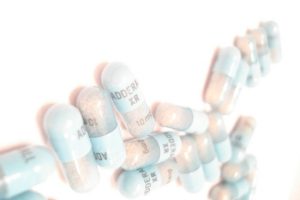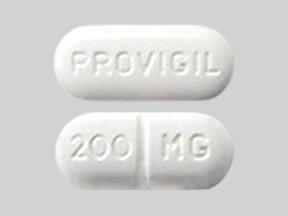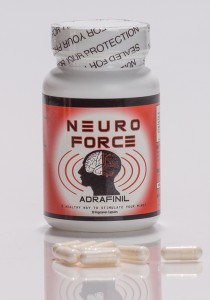Modafinil vs Adderall: Similarities and Differences
Similarities
 Modafinil and Adderall (amphetamine) are psychostimulants indicated for attention deficit hyperactivity disorder (ADHD), narcolepsy, and sleep disorders arising from shift work (Steiner & Van Waes, 2013). Adderall and modafinil act on the norepinephrine (NE), dopamine (DA), and serotonin (5-HT) transporters to significantly boost the amount of extracellular monoamines in the central nervous system (Natarajan & Yamamoto, 2011). They reverse or inhibit the reuptake of these three neurotransmitters to achieve prolonged action. Transporter inhibition also leads to the release of monoamine stores inside neurons that also amplify wakefulness, memory, and attention (Wood et al., 2013).
Modafinil and Adderall (amphetamine) are psychostimulants indicated for attention deficit hyperactivity disorder (ADHD), narcolepsy, and sleep disorders arising from shift work (Steiner & Van Waes, 2013). Adderall and modafinil act on the norepinephrine (NE), dopamine (DA), and serotonin (5-HT) transporters to significantly boost the amount of extracellular monoamines in the central nervous system (Natarajan & Yamamoto, 2011). They reverse or inhibit the reuptake of these three neurotransmitters to achieve prolonged action. Transporter inhibition also leads to the release of monoamine stores inside neurons that also amplify wakefulness, memory, and attention (Wood et al., 2013).
Both modafinil and adderall are also being used in academic doping or the off-label use of the drugs for cognitive enhancement among students. They are also called memory enhancers or smart drugs.
In studies of adderall, healthy persons were shown to benefit from low doses through enhanced working memory or short-term and rote memory as compared with placebo (Wood et al., 2013). The effects on memory coincided with minor increases in prefrontal cortex activation as shown by imaging. However, higher doses are known to induce euphoria and the opposite effect of cognitive impairment.
Modafinil use has similarly been associated with improved cognitive functions and attention in healthy subjects without adverse effects or indications of tolerance (Akintomide & Rickards, 2011; Wood et al., 2013). It is important to note, however, that there is insufficient evidence showing better academic performance among students who use modafinil or adderall as smart drugs than those who do not. This is because both drugs influence short term memory and rote memory but not more complex cognitive functions such as creativity and concept analysis and application. At the same time, the placebo effect cannot be discounted (Lakhan & Kirchgessner, 2012).
Differences
There are differences in the off-label uses of modafinil vs adderall. In studies, adderall was used in enhancing the working memory and language production of patients with schizophrenia, spatial and verbal memory among those with multiple sclerosis with cognitive impairment, and improved recovery in stroke patients in regards to aphasia (Wood et al., 2013). On the other hand, off-label uses of modafinil include ADHD, depression, bipolar disorder, Parkinson’s disease, Alzheimer’s disease, fatigue, and cocaine addiction (Kim, 2012).
Comparisons as Cognitive Enhancers
Adderall (amphetamine) is a Schedule II substance while modafinil is Schedule IV (Lakhan & Kirchgessner, 2012; Steiner & Van Waes, 2012). This means that adderall has a higher potential for inducing addiction compared with modafinil. Non-therapeutic doses of adderall induce abuse and dependence. If adderall is taken at moderate to high doses or increased without the benefit of gradual increase or titration, the sudden increase in dopamine level induces euphoria (De Sousa & Kalra, 2012). Tolerance also develops with prolonged use of adderall and symptoms of rebound manifest when the desired effects wane (Kim, 2012).
There have been no reports of euphoria with therapeutic doses of modafinil. At increased doses, the drug at 150-250 mg/kg was shown to be a weak reinforcer when used by persons abusing other  drugs and induces a “high” similar to methylphenidate (Wood et al., 2013). The lower probability of addiction lies in the drug’s pharmacokinetics and pharmacodynamics wherein modafinil has a slower onset and a longer half-life of 12-15 hours compared with adderall (De Sousa & Kalra, 2012; Kim, 2012). At the same time, it influences norepinephrine and serotonin transporters more than dopamine whereas adderall primarily interacts with dopamine. Large increases in dopamine in the brain are associated with euphoria (Steiner & Van Waes, 2012). In addition, modafinil may also counter fatigue as shown in human studies involving soldiers with combat fatigue brought about by fear, anxiety, sleep deprivation, and long hours of duty (Kim, 2012).
drugs and induces a “high” similar to methylphenidate (Wood et al., 2013). The lower probability of addiction lies in the drug’s pharmacokinetics and pharmacodynamics wherein modafinil has a slower onset and a longer half-life of 12-15 hours compared with adderall (De Sousa & Kalra, 2012; Kim, 2012). At the same time, it influences norepinephrine and serotonin transporters more than dopamine whereas adderall primarily interacts with dopamine. Large increases in dopamine in the brain are associated with euphoria (Steiner & Van Waes, 2012). In addition, modafinil may also counter fatigue as shown in human studies involving soldiers with combat fatigue brought about by fear, anxiety, sleep deprivation, and long hours of duty (Kim, 2012).
Modafinil vs Adderall: Side Effects
Adderall
In terms of side effects, adderall use is associated with adverse cardiac effects especially among patients with hypertension, heart problems, heart defects, and of a family history of such conditions (United States Food and Drug Authority, 2013). It can also cause problems in the peripheral microcirculation such as Raynaud’s phenomenon. Further, adderall can cause psychiatric symptoms such as psychosis and aggression. Side effects at therapeutic doses include headache, weight loss, insomnia, irritability, nausea, and pain in the upper abdomen (Najib, 2009).
Modafinil
On the other hand, the side effects of modafinil are similarly headache, insomnia, and nausea but also include dry mouth, anxiety, chest pain, palpitations, tachycardia, and skin reactions (Akintomide & Rickards, 2011).
Obtaining Modafinil and Adderall: Where to buy?

Both modafinil and adderall are prescription drugs. Diversion is a common way of accessing modafinil and adderall without a prescription. A survey shows that among medical students, one practice was selling or giving away one’s prescription medication (Emanuel et al., 2012). Requests to undergo diagnosis for ADHD have increased among students as well. Misuse of their own prescription medications was also noted in an online survey of university students (Teter et al., 2007). However, modafinil is said to be available in markets in India (De Sousa & Kalra, 2012) probably because of less stringent drug regulatory measures, and both modafinil and adderall are sold by several websites, albeit illegally (Kim, 2012).
Alternatives to Modafinil and Adderall
There are some nootropics and cognitive enhancers available to the market that may be alternatives to modafinil and adderall. We suggest learning more about nootropics and the benefits and/or side effects before considering the use of any of them. The following links contain helpful information regarding the functions of some alternatives:
Phenylpiracetam: What is Phenylpiracetam?
Adderall vs Modafinil References
Akintomide, G.S., & Rickards, H. (2011). Narcolepsy: A review. Neuropsychiatric Disease and Treatment, 7, 507-518. doi: 10.2147/NDT.S23624.
De Sousa, A., & Kalra, G. (2012). Drug therapy of attention deficit hyperactivity disorder: Current trends. Mens Sana Monographs, 10(1), 45-69. doi: 10.4103/0973- 1229.87261.
Emanuel, R.M., Frellsen, S.L., Kashima, K.J., Sanguino, S.M., Sierles, F.S., & Lazarus, C.J. (2013). Cognitive enhancement drug use among future physicians: Findings from a multi-institutional census of medical students. Journal of General Internal Medicine, 28(8), 1028-1034. doi: 10.1007/s11606-012-2249-4.
Kim, D. (2012). Practice use and risk of modafinil, a novel waking drug. Environmental Health and Toxicology, 27, e2012007. doi: 10.5620/eht.2012.27.e2012007.
Lakhan, S.E., & Kirchgessner, A. (2012). Prescription stimulants in individuals with and without attention deficit hyperactivity disorder: Misuse, cognitive impact, and adverse effects. Brain and Behavior, 2(5), 661-677. doi: 10.1002/brb3.78.
Najib, J. (2012). Lisdexamfetamine in the treatment of adolescents and children with attention-deficit/hyperactivity disorder. Adolescent Health, Medicine and Therapeutics, 3, 51-66. Retrieved from http://www.dovepress.com/getfile.php?fileID=12699.
Natarajan, R., & Yamamoto, B.K. (2011). The basal ganglia as a substrate for the multiple actions of amphetamines. Basal Ganglia, 1(2), 49-57. doi: 10.1016/j.baga.2011.05.003.
Steiner, H., & Van Waes, V. (2013). Addiction-related gene regulation: Risks of exposure to cognitive enhancers vs. other psychostimulants. Progress in Neurobiology, 100, 60- 80 . doi: 10.1016/j.pneurobio.2012.10.001.
Teter, C.J., McCabe, S.E., LaGrange, K., Cranford, J.A., & Boyd, C.J. (2006). Illicit use of specific prescription stimulants among college students: Prevalence, motives, and routes of administration. Pharmacotherapy, 26(1), 1501-1510. doi: 10.1592/phco.26.10.1501.
United States Food and Drug Authority (2013). Medication guide: Adderall XR. Retrieved from http://www.fda.gov/downloads/Drugs/DrugSafety/ucm085819.pdf
Wood, S., Sage, J.R., Shuman, T., & Anagnostaras, S.G. (2013). Psychostimulants and cognition: A continuum of behavioral and cognitive activation. Pharmacological Reviews, 66, 193-221. Retrieved from http://dx.doi.org/10.1124/pr.112.007054
Smart Drugs for Thought (2015). Modafinil vs Adderall: Similarities and Differences